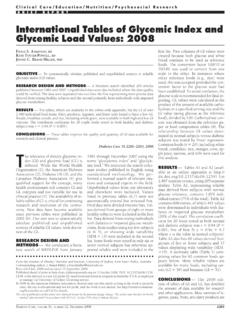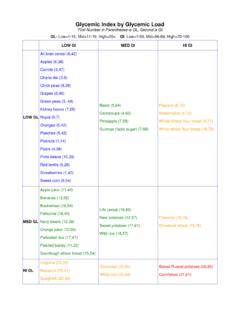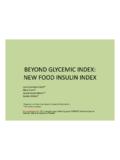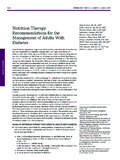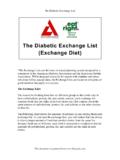Transcription of The Role of Glycemic Index & Glycemic Load on …
1 19201 E. MainstreetSuite 103 Parker, CO 80134 Phone: (303) 840-8787 Fax: (303) Role of Glycemic Index & Glycemic load on CarbohydrateFood Quality: A Status ReportG l y c e m i c I n d e x1 Table of ContentsExecutive Summary ..2 Introduction ..3 Carbohydrates and Glycemic Response Measures ..4 Table 1 ..5 Table 2 ..6 Table 3 ..8 Table 4 ..8 Table 5 ..8 The GI Measurement Issues and Controversy ..9 Factors Affecting the Variability of the Index ..9 Table 6 ..9 Table 7 ..9 Table 8 ..10 Table 9 ..11 Glycemic Index in the Clinical Setting ..12 Glycemic Index and Body Weight, Weight Loss and Satiety ..12 GI/GL and Body Weight ..12 Glycemic Index , Glycemic load and Weight Loss ..13 Glucose Release, Insulin Release and Insulin Sensitivity ..13 Hunger, Satiety, Palatability and Satisfaction with GI/GL Diets ..14 Glycemic Index , Glycemic load and Prevention and Treatment of Diabetes ..15 GI, GL and Prevention of Diabetes ..15 Text Box 1 Nutrition Recommendations and Interventions for Prevention of Diabetes.
2 17 Glycemic Index and Loading in Treating T2DM ..18 Text Box 2 Nutrition Recommendations for the Management of Diabetes CHO in Diabetes Management ..18 Glycemic Index , Glycemic load and Gestational Diabetes ..20 Pre-Diabetes and the Insulin Resistance Sydrome and GI/GL ..20 Glycemic Index , Glycemic load and Markers of Coronary Risk and Cardiovascular Disease ..21 GI/GL, Blood Lipids and Markers of Coronary Risk ..21 GI/GL, Stroke and Cardiovascular Disease ..21 Glycemic Index , Glycemic load and Cancer ..22 Breast Cancer ..22 Text Box 3 - Prospective Studies Which Show No Association of GI and GL with Breast Cancer ..23 Glycemic Index , Glycemic load and Colon Cancer Risk ..23 Glycemic Index , Glycemic load and Pancreatic Cancer ..24 Glycemic Index , Glycemic load and Other Cancers ..24 Summary for Glycemic Index and Glycemic load for all Cancers ..26 Glycemic Index for Athletes ..26 Conclusions ..27 List of Acronyms ..29 Glossary ..29 References ..322G l y c e m i c I n d e xCarbohydrate food quality has become a hot topic due to its link with Glycemic response and chronic diseases.
3 Yet, Glycemic response as measured by Glycemic Index (GI) and Glycemic load (GL) is variable. Further, there is misleading use of GI and GL due to lack of understanding regarding what is being compared and that the comparison is of 50g of available CHO (not food) and 50g of glucose. To add to this problem within and between lab variations, plant varietal differences and cooking methods produce other sources of variability. The measure is done with a single food eaten alone, but foods are not usually eaten alone, but in combination, thereby adding more variability. These sources of variability suggest that assigning numbers to individual foods would not only be difficult and too imprecise for food labeling, but also that it would fail to adequately inform the consumer. To add to the complexity, markedly different diets can have the same Glycemic score. Thus, tying either GI or GL to chronic disease endpoints is very difficult and this has been shown in a number of instances. For example, data linking GI/GL to either weight maintenance or long-term weight loss is inconsistent, despite the fact that some studies indicated that low GI or GL diets, compared those higher in GI or GL, may be weakly associated with greater satiety and reduced hunger.
4 In terms of the risk of type 2 diabetes mellitus (T2DM), high dietary GI or GL is associated in some studies. However, the pattern is inconsistent and has confounders such as age, BMI, lifestyle and other dietary factors especially dietary fiber. Diets low in dietary fiber are strongly associated with increased risk of T2DM and the association is amplified when diets are high in dietary GI or GL. While data exist which both support and contradict benefits of low GI/GL diets in the management of diabetes, the American Diabetes Association recommends that diabetics consuming high GI diets switch to lower GI diets to help control postprandial are inconsistent on the role of low-GI diets on risk factors for coronary heart disease (CHD) and cancer. Some studies show a small reduction in total cholesterol and markers of inflammation for hyperlipidemic subjects selecting low GI diets compared with high GI diets. The role of GI or GL in cancer risk is inconsistent and depends on the type of cancer.
5 While case-control studies showed positive associations between GI and GL intake for a number of types of cancers, pooled cohort studies showed no consistent associations between colorectal, pancreatic, breast cancer or other cancer risks and GI or GL. Further studies are needed which improve the assignment of GI and GL to the diet along with careful choice of subjects in the carbohydrate in the diet appears to trump the GI or GL of the diet when considering fuel for exercise. For the meal prior to endurance exercise, data indicate there may be a competitive advantage to selecting low-to-moderate GI/GL foods, and limited data indicating an advantage of a higher GI/GL diet or food for replenishing glucose after SummaryGlycemic indexG l y c e m i c I n d e x3 Scrutiny surrounding the quality of carbohydrate (CHO) foods has in the last decade started to approach that of fats. Large epidemiological studies have linked the Glycemic response to chronic diseases by associating low Glycemic Index (GI) or Glycemic load (GL) diets with a number of positive health impacts.
6 These include: (1) improved Glycemic control in diabetic subjects, which is associated with reduced risk of diabetes, (2) more favorable lipid profiles, which are associated with lower risk of cardiovascular disease, and (3) reduced markers of inflammation, which are associated with lower risk of metabolic syndrome, overweight and other chronic diseases. A few studies have shown associations between dietary GI/GL and the risk of colon, breast and other cancers. Despite studies that indicate associations, there are also a number of studies that fail to link GI/GL of the diet with health and disease risk. Two major possibilities may account for the lack of consistency among studies. One has to do with potential confounding due to diet quality. The other is related to variability associated with the method of determining GI and GL in the In terms of confounding, low GI/GL diets could be linked to reduced disease risk because they are comprised of fruits, vegetables, nuts, legumes and whole grains.
7 These inherently nutrient intense, phytochemical-rich, high fiber foods all have the capacity to lower disease risk regardless of their ,3 On the other hand, foods and diets can have a low GI/GL if they contain low GI sweeteners such as fructose or are high in meat and fat. These widely variant diets are likely to have quite different effects. In like manner, foods with a high GI/GL could be positively associated with daily consumption of highly processed snacks, and negatively associated with consumption of nutrient-rich Thus, a high dietary GI/GL may reflect food patterns less likely to deliver disease-protecting nutrients. Thus the GI/GL of some diets may be more about what is or is not present with the CHO rather than Glycemic effect of the CHO. The determination of the GI of a food, even in closely controlled laboratory conditions by experienced analysts, creates large standard deviations even for one individual, so the measure s precision and accuracy is subject to question by In like manner, determination of the dietary GI or GL from food frequency also has many potential sources of This is compounded by the fact that changes in amounts of the food or combinations of foods may change the measured Glycemic contend that, despite the variability, using the GI/GL concept is important in making diet selections, and that GI/GL should be controlled for both treatment and prevention of chronic diseases.
8 Detractors contend that the measure s variability makes the use of GI/GL valuable only in a laboratory setting. Thus carbohydrate foods find themselves front-and-center in a nutritional controversy. No longer are they viewed merely as a staple or as a source of energy, but rather they have been added to a list of food components to be evaluated when deciding how much and which type to include in the diet. This review will focus on studies that have been published since the prior review (Jones, 2002) and will cover the measures of blood glucose, the variability of the measure, the relationship of GI and GL to diabetes, weight control, coronary heart disease and other chronic diseases and its role in fueling endurance sports. Also included are recommendations, regulations and current consumer understanding regarding use of GI and GL in the l y c e m i c I n d e xFigure 1A Old Paradigm of Glucose Response Curves - Pre 1970 Figure 1B Actual Glucose Response Curves SugarsStarchesLegumesFructose PotatoGlucoseTimeBlood GlucoseBlood GlucoseTimeThe nutrition of CHOs was thought to be quite simple.
9 Physiological effects of digestible carbohydrates were thought to be directly related to whether the CHO was classed as simple, containing one or two sugar units (a mono- or disaccharide), or complex, containing multiple sugar units (a polysaccharide). In the old paradigm, all simple sugars were assumed to enter the bloodstream quickly, and all complex CHOs, because they would need to be broken down by digestive enzymes, would enter the bloodstream slowly (Figure 1A). Despite the fact that data from the 1930s indicated that this paradigm might be in error,6 it was not until the 1970s that this nutritional dogma was actively These data showed that some complex CHOs could have a Glycemic response similar to simple sugars and vice versa, which yielded a new paradigm (Figure 1B). In 1981, David Jenkins and his colleagues at the University of Toronto developed a method to quantify the effect of various carbohydrates on the blood glucose response in people with diabetes. Thus, the GI concept was Subsequently the GL was derived in an attempt to consider quantity of carbohydrate.
10 Simply stated the Glycemic Index measures how quickly a carbohydrate enters the bloodstream and elevates blood sugar. The actual GI measurement compares the standard blood glucose-raising effects of ingesting 50g of a standard, usually glucose, to ingesting 50g of available CHOi from a particular food. The measurement follows the rise and fall in blood glucose,i which is measured as the area-under-the-curve (AUC) for a 2-hour time period after ingestion of the test food or standard glucose. For each subject, the AUC for Carbohydrates and Glycemic Response Measuresglucose is arbitrarily assigned the value of 100. The GI is a ratio calculated by comparing the AUC observed with the feeding of the test food to the AUC with must be pointed out that GI compares equal amounts of available CHO (Figure 2) in the test food to 50g of glucose. Many diet books, popular press articles, and even some health professionals erroneously promote that the measure compares identical gram amounts of food, , that it compares the blood glucose curves of 50g of test food to 50g of fail to understand that the quantity of food needed to reach 50g of available CHO may differ dramatically.
